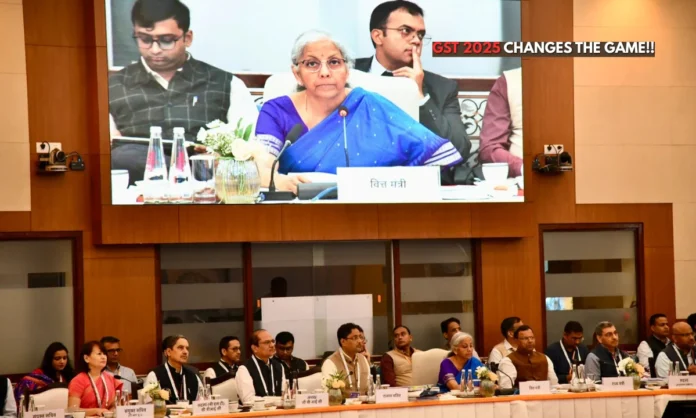Key Highlights
- GST reforms in 2025 reduce tax slabs to two main rates, easing tax burdens for consumers and businesses.
- Finance Minister Nirmala Sitharaman highlighted the government’s pivotal role in driving these GST reforms.
- The 2025 GST reforms aim to simplify taxation, promote equity, and support economic growth across India.
Opening Overview
GST reforms in 2025 are central to India’s ongoing economic transformation. The government’s focus on the revised GST aims to simplify the complex tax system, alleviate burdens on taxpayers, and enhance compliance across sectors. Finance Minister Nirmala Sitharaman emphasized the importance of these GST reforms in creating a fairer and more efficient tax environment. The revised GST reduce multiple tax slabs, making the system more transparent and easier to navigate for citizens and businesses alike. By focusing on MSMEs, farmers, and everyday consumers, the revised GST in 2025 seek to bring inclusive benefits and stimulate economic growth.
Reforms in GST have added Panchratna (five aspects) to India's economy.
— BJP (@BJP4India) September 4, 2025
First, the tax system has become much simpler.
Second, the quality of life of the citizens of India will improve further.
Third, both consumption and growth will get a new boost.
Fourth, ease of doing… pic.twitter.com/GSK7ciLCGu
The Legacy of Taxation and the Need for GST reforms
- GST reforms in 2025 replace decades-old complex tax structures with a unified, streamlined system.
- Historical heavy tax rates imposed high burdens, creating a need for the revised GST.
- GST reforms signify a shift from high, complicated taxes toward a more growth-oriented and equitable tax system.
India’s previous tax regime was marked by high income and indirect taxes that created inefficiencies and restricted economic expansion. The revised GST in 2025 have been introduced as a crucial step to unify and simplify the system, replacing a fragmented legacy. The extreme rates of the past stand in contrast with the more moderate, growth-friendly design of the revised GST, which prioritize ease of compliance and economic inclusivity.
Core Features and Impact of the revised GST in 2025
- GST reforms simplify slabs to 5% and 18%, significantly easing tax burdens on essential goods and consumer durables.
- These revised GST prioritize MSMEs, farmers, and small businesses, promoting ease of doing business.
- Digital enhancements under the revised GST enable faster filing and refunds, making tax compliance smoother and more efficient.
The 2025 revised GST mark a decisive move to reduce complexity, strengthen economic participation, and improve tax administration. By consolidating slabs and lowering rates on many items, the revised GST is designed to stimulate demand and boost growth. Focused measures under these reforms support key sectors such as agriculture and micro-enterprises, further driving inclusive prosperity. Enhanced digital infrastructure ensures the revised GST translate into faster, more transparent processes for taxpayers.
Political Debate Surrounding GST reforms
- Congress initially criticized GST as “Gabbar Singh Tax” but now claims credit for aspects of the GST reforms.
- The government refutes these claims, attributing the revised GST to their vision and leadership under PM Modi.
- Political debates around the revised GST continue, though the reforms themselves focus on reducing tax complexity and burden.
GST reforms have been a politically charged subject since their introduction. While the Congress party had once derided GST for its complexity, it now attempts to associate with recent reform efforts. Finance Minister Sitharaman has challenged the opposition’s stance, highlighting the government’s commitment to executing impactful the revised GST. Despite political contention, these reforms demonstrate the government’s drive to ensure a simpler, fairer tax system for all Indians.
Economic Significance and Empirical Support for GST reforms
- Official data shows increased compliance and revenue efficiency following the revised GST.
- GST reforms help stabilize consumer prices and enhance demand in the post-pandemic economy.
- RBI and IMF reports affirm that revised GST play a vital role in supporting India’s macroeconomic health and sustainable growth.
Data and institutional analyses back up the positive impacts of the revised GST in 2025. Improved compliance and streamlined GST reforms contribute to healthier tax revenues and greater economic stability. By lowering indirect taxes on essential goods, these reforms help keep inflation in check and boost consumer confidence. Leading economic institutions recognize GST reforms as key drivers of India’s ongoing fiscal consolidation and growth momentum.
Final Perspective
GST reforms in 2025 stand as a foundational pillar of India’s fiscal modernization. Led by Finance Minister Nirmala Sitharaman, these reforms reduce complexity, ease the tax burden, and promote inclusive growth. Despite political contestation, the revised GST exemplify a government committed to economic progress and tax fairness. Moving forward, the revised GST will continue to shape India’s tax landscape, benefiting citizens, businesses, and states alike through simplified, efficient, and equitable tax policy.


